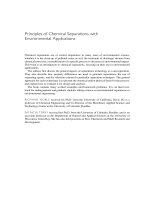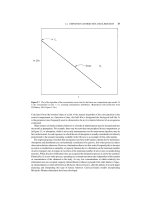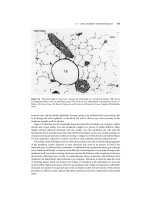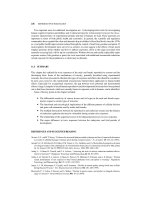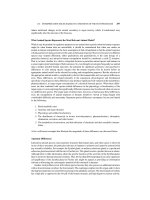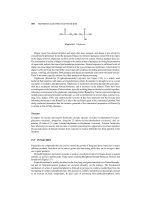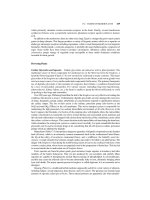Principles of environmental physiscs 4nd
Bạn đang xem bản rút gọn của tài liệu. Xem và tải ngay bản đầy đủ của tài liệu tại đây (11.52 MB, 403 trang )
Principles of Environmental Physics
Fourth Edition
Principles of
Environmental Physics
Plants, Animals, and the Atmosphere
Fourth Edition
John L. Monteith† and Mike H. Unsworth
AMSTERDAM • BOSTON • HEIDELBERG • LONDON • NEW YORK
OXFORD • PARIS • SAN DIEGO • SAN FRANCISCO • SINGAPORE
SYDNEY • TOKYO
Academic Press is an imprint of Elsevier
†
Deceased.
Academic Press is an imprint of Elsevier
The Boulevard, Langford Lane, Kidlington, Oxford OX51GB, UK
Radarweg 29, PO Box 211, 1000 AE Amsterdam, The Netherlands
225 Wyman Street, Waltham, MA 02451, USA
525 B Street, Suite 1900, San Diego, CA 92101-4495, USA
Fourth Edition
Copyright © 2013, 2008 Elsevier Ltd. All rights reserved.
No part of this publication may be reproduced, stored in a retrieval system or transmitted in any form
or by any means electronic, mechanical, photocopying, recording or otherwise without the prior written
permission of the publisher.
Permissions may be sought directly from Elsevier’s Science & Technology Rights Department in
Oxford, UK: phone (+44) (0) 1865 843830; fax (+44) (0) 1865 853333; email: permissions@
elsevier.com. Alternatively you can submit your request online by visiting the Elsevier web site at
and selecting Obtaining permission to use Elsevier material.
Previous Editions
1990, 1975 Edward Arnold Publishers Ltd.
Notice
No responsibility is assumed by the publisher for any injury and/or damage to persons or property as
a matter of products liability, negligence or otherwise, or from any use or operation of any methods,
products, instructions or ideas contained in the material herein. Because of rapid advances in the
medical sciences, in particular, independent verification of diagnoses and drug dosages should be
made.
British Library Cataloguing-in-Publication Data
A catalogue record for this book is available from the British Library
Library of Congress Cataloging-in-Publication Data
A catalog record for this book is available from the Library of Congress
For information on all Academic Press publications visit
our web site at store.elsevier.com
Printed and bound in Poland
13 14 15 16 17 10 9 8 7 6 5 4 3 2 1
ISBN: 978-0-12-386910-4
Preface to the Fourth Edition
Sadly, John Monteith, my colleague, mentor and friend, died in July 2012 before this
edition was complete. For more than 50 years he pioneered the application of physics
to the study and analysis of biological processes. He began his career in the Physics
Department of Rothamsted Experimental Station, where his collaboration with Howard
Penman led to the Penman-Monteith equation that has been so influential in ecophysiology and hydrology for estimating evaporation and transpiration. At Rothamsted he
also collaborated with Geza Szeicz and others in designing and building some of the
first instruments for Environmental Physics, including early versions of tube solarimeters and porometers that became much-used tools for investigating canopy and leaf
environments. He was also among the first to use infrared gas analyzers for micrometeorological measurements of the carbon dioxide exchange of crop canopies.
In 1967 he moved to the University of Nottingham School of Agriculture where he
built up the first academic department with a focus on Environmental Physics. The first
edition of this book in 1973 was derived from the course that he developed there for
senior undergraduates, which was unique in covering both plant and animal interactions
with the environment. The text quickly became essential reading for researchers in the
expanding field of Environmental Physics worldwide and was translated into several
languages. When I joined John as co-author for the second edition (1990), we updated
the book, expanded several chapters, and added new sections on non-steady-state heat
balances and on particle and pollutant gas transfer in recognition of the emerging
discipline that would eventually be termed biogeochemistry.
By the time of the third edition (2008), Environmental Physics had expanded rapidly,
driven by concerns over increasing global carbon dioxide concentrations and changing
climate. In particular, research on the carbon and water budgets of forests and natural
vegetation had greatly increased. Availability of new fast-response instrumentation for
trace gas measurement allowed the previously esoteric micrometeorological method
of eddy covariance measurement to be widely applied. Consequently we added more
material about eddy covariance and included more examples of applications in forest
science. We also responded to requests to include more worked examples and problem
sets for student use. The Preface to the Third Edition, which is reproduced below,
captures many of John’s insights into the development of Environmental Physics, and
reveals some of the thinking behind how this book is structured and the conventions
we have chosen to adopt.
This fourth edition provides an opportunity to improve on the presentation of material, update the core chapters, and summarize some of the highlights of the huge expansion in published work in Environmental Physics over the past decade. In keeping with
the title, we have chosen to focus on principles; readers seeking more advanced treat-
viii
Preface to the Fourth Edition
ments of topics are encouraged to explore some of the texts mentioned in the Bibliography. In choosing examples from published research we have continued our practice
of focusing on work that presents new insights and applies principles from the text;
this becomes increasingly challenging as Environmental Physics grows, so we have
included many new references aimed to help readers follow up on emerging topics.
It has always been our aim to keep the mathematics in this book at a level accessible to readers competent in algebra but not necessarily familiar with calculus. We
have responded to suggestions from our students and others by expanding many of
the algebraic derivations to show intermediate steps, and we have placed some of the
more complex mathematics in text boxes which could be omitted by the general reader.
More has been included about the Penman-Monteith equation and its applications, and
about coupling of vegetation to the atmosphere. And we have increased the material
on eddy covariance and modified the presentation of gradient methods in micrometeorology so that much of the discussion of non-neutral stability could be bypassed.
We are grateful to our many students and colleagues who have given us feedback
on their use of this book and have provided many of the research examples that are
mentioned in the text. Comments (both positive and negative!) on this edition will be
most welcome and can be addressed to
Mike Unsworth, 2013.
Companion Website
Visit this book’s companion website to access additional content.
/>
Preface to the Third Edition
In the time since the first edition of Principles of Environmental Physics was published
in 1973 the subject has developed substantially; indeed, many users of the first and
second editions have contributed to the body of research that makes this third edition
larger than the first. From the start, this text has been aimed at two audiences: first,
undergraduate and graduate students seeking to learn how the principles of physics can
be applied to study the interactions between plants and animals and their environments;
and second, the research community, particularly those involved in multidisciplinary
environmental research. In many ways, environmental physics has become more thoroughly embedded in environmental research over the decades. For example, in ecology
and hydrology, concepts of atmospheric exchange of gases and energy between organisms and the atmosphere, and the resistances (or conductances) controlling them are
commonly applied. And in atmospheric science, soil-vegetation-atmosphere transfer
schemes (SVATS) are an integral part of general circulation, mesoscale, and climate
models. This “union of ideas” across the disciplines has made it challenging to define
the scope of this third edition and to keep the size manageable. In doing so we have
been guided by the word “Principles” in the title, so have focused, as in previous editions, on describing the critical principles of energy, mass, and momentum transfer,
and illustrating them with a number of examples of their applications, taken from a
range of classic and more recent publications.
Several themes have waxed and waned over the editions. At the time of the first edition, agricultural crop micrometeorology was a dominant application of environmental
physics, beginning with the desire to quantify the water use and irrigation requirements
of crops, and extending, as new instrumentation became available, to the analysis of
carbon dioxide exchange in efforts to identify the environmental controls of crop productivity. There has been much less new work on agricultural crop micrometeorology
in the last decade or two, but applications of environmental physics to the study of
managed and natural forests and other ecosystems gathered pace through the 1970s
and 1980s, and probably currently account for a larger fraction of the annual reviewed
publications in environmental physics than agricultural applications. Also in the 1970s
and 1980s, concerns over human influences on air quality (particularly acid rain and
ozone) grew, leading to the application of environmental physics to study fluxes of pollutant gases, acidic particles, and mist to crops and forests. Additionally, the technology
for remote sensing from satellites developed considerably.
The second edition of Principles of Environmental Physics, published in 1990,
reflected these developments by adding a new chapter on particle transfer, new material on radiative transfer, and expanding the sections on micrometeorological methods. It also expanded treatment of the environmental physics of animals and their
x
Preface to the Third Edition
environments, influenced by the work of a number of researchers studying the heat balance of livestock and wild animals, who began to use the terminology of environmental
physics, thus establishing parallels with the integration of environmental physics into
plant science. The identification of the ozone hole above Antarctica in 1985, and its
influence on ultraviolet radiation at the surface received a short mention in the second
edition, but emerging research on deposition of nitrogen-containing gases to vegetation
was not covered; both topics receive more attention in this edition.
Through the 1980s, extending to the present time, concern over rising concentrations
of carbon dioxide and other greenhouse gases in the atmosphere and consequent likely
effects on climate has been a dominant topic, leading to an explosion of measurement
and modeling research programs that make use of principles described in this book. Two
developments have been particularly important: improved instrumentation allowing
the eddy covariance technique in micrometeorology to be applied for studies of landatmosphere exchange of carbon dioxide, water vapor, and some other trace gases over
seasonal and multi-annual periods; and theoretical advances to enable models of plantatmosphere exchange to be scaled up from the leaf scale to landscape, regional and even
global scales, creating links between the principles described in this book at organism
and canopy levels with the type of regional and global modeling necessary to address
climate-change concerns. This edition contains two substantially revised chapters on
micrometeorology with expanded treatment of the eddy covariance method, and which
contain several new case studies to illustrate the application of micrometeorological
methods over forests and natural landscapes. We have also expanded the material on
solar and terrestrial radiation with new discussion of the roles of radiatively active
greenhouse gases and aerosols.
Although eddy covariance has become the method of choice for micrometeorology in
many situations, we have retained the material describing profile (similarity) techniques
for deducing fluxes, because an understanding of similarity methods is essential for
large-scale models and because profile methods have advantages in terms of simplicity
of instrumentation when designing student projects or working with limited resources.
A number of other changes in this edition have resulted from our own experience
and feedback from others using this book as a teaching text: several sections that were
particularly condensed in earlier editions have been expanded to aid clarity, and some
sections have been rearranged to improve the flow; more worked examples have been
included in the text; some specialized material (for example, details of the physics of
radiative emission and of radiation interaction with aerosols) has been added in text
boxes that can be omitted by readers seeking a briefer treatment of the subject; and
numerical problems have been added at the end of each chapter. Many of the numerical
problems are more extensive than typically found in textbooks. This reflects requests we
have had over the years from teachers who would like to explore realistic applications
of the subject; many of the problems have been used in our own undergraduate and
graduate teaching at Nottingham and Oregon State Universities, and we thank many
students for their feedback and suggestions for improvements to the problems.
In planning this third edition we debated whether to change nomenclature in flux
equations from resistances to conductances, and whether to express quantities in “mole”
units rather than “m-kg-s” units. Biologists increasingly use conductances and moles
Preface to the Third Edition
xi
in their analyses, and there are some good theoretical and didactic arguments for this.
But, on balance, we preferred to retain the “resistance” terms and “s m−1 ” units used
in earlier editions: the analogy with Ohm’s Law emphasizes the underlying physics of
many analyses used in this book, and units of s m−1 for resistances are more intuitive
for heat and mass transfer calculations in energy balance and hydrological applications.
Nevertheless, we recognize that many readers will be familiar with conductance and
mol units, so we have discussed conversions of units at several appropriate points
in the text. There are many advantages in environmental physicists trying to become
comfortable in working with both systems of units to facilitate communication across
the disciplines.
We intend this text to be useful for teaching undergraduates and graduate students
specializing in physics, biology, and the environmental sciences. The mathematical
treatment is deliberately kept relatively simple, with little use of calculus; the biology
is also strictly limited, consisting principally of material essential for understanding the
physical applications. There is a bibliography directing readers to more detailed texts
if necessary. For our other category of readers, research scientists, we have continued
the approach of previous editions by including a large number of references to the
peer-reviewed literature, identifying a mix of papers that we consider classics and
ground-breaking research applications; more than 30 of the references in this edition
have been published since 1990.
In the preface to the second edition we expressed the hope that our book would
encourage more university physics departments to expose their students to environmental physics. Our impression is that progress has been slow. This surely cannot
be because of a lack of career opportunities—current environmental concerns open
many possibilities for environmental physicists in the atmospheric sciences, hydrology, ecology, and biology, particularly if they enjoy the challenges of multidisciplinary
work. Nor does it seem to be because physics students lack interest in environmental subjects. Perhaps it is inevitable that the crowded physics curriculum leaves little
room for options such as environmental physics, but it would be satisfying if, by the
time the fourth edition of this book appears, environmental physics was as common as
astronomy or meteorology as an optional course in physics departments.
John Monteith and Mike Unsworth, 2006.
Acknowledgments
We thank the following for allowing us to use diagrams, photographs, and original
data:
Drs R. Keeling and P. Tans, and the database provided by the US Department
of Energy through its Carbon Dioxide Information Analysis Center (Figure 2.2);
Dr. G. Kopp for providing the data used in Figure 5.1; Dr. S.T. Henderson and Adam
Hilger Publishers (Figure 5.2); Dr. J.A. Coakley (Figure 5.3); The British Antarctic
Survey (Figure 5.4); The Solar Energy Research Institute for the computer models
used to construct Figure 5.5; Dr. M.D. Steven and the Royal Meteorological Society
(Figure 5.6) from the Quarterly Journal of the Royal Meteorological Society; Dr. F.
Vignola for providing the data used in Figure 5.8; Dr. J.V. Lake for providing the data
used in Figure 5.9; Mr. F.E. Lumb and the Royal Meteorological Society (Figure 5.10)
from the Quarterly Journal of the Royal Meteorological Society; Dr. R. von Fleischer
and the Deutschern Wetterdienstes (Figure 5.15); Dr. R. Nakamura for providing the
data used in Figure 5.17; Dr. K. Bible for providing the data used in Figure 5.18;
Dr. E.L. Deacon and Elsevier Publishing Co. (Figures 6.1 and 15.7); Dr. S.A. Bowers
and Lippincott Williams and Wilkins Co. (Figure 6.3) from Soil Science; Dr. K.J.
McCree and Elsevier Publishing Co. (Figure 6.4) from Agricultural Meteorology;
Dr. G. Stanhill and Pergamon Press (Figure 6.6) from Solar Energy; Professor L.E.
Mount and Edward Arnold (Figures 6.7, 14.3, and 14.4); Dr. J.C.D. Hutchinson
and Pergamon Press (Figure 6.8) from Comparative Biochemistry and Physiology;
Dr. W. Porter for providing data used in Figure 6.9; Dr. C.R. Underwood and Taylor
and Francis Ltd (Figure 7.5) from Ergonomics; Dr. G.S. Campbell and Nottingham
University Press (Figure 8.3) Dr. K. Cena and the Royal Society of London (Figure
8.6) from the Proceedings of the Royal Society; Dr. J. Grace and Oxford University
Press (Figure 9.3) from Journal of Experimental Botany; The Royal Meteorological
Society (Figures 9.4, 9.5, 13.6, 13.7, 13.8, 13.9, 15.3, 17.13, and 17.14) from
the Quarterly Journal of the Royal Meteorological Society; Dr. W.C. Hinds and
John Wiley & Sons Inc. (Figures 9.6, 12.7, 12.8, 12.9, 12.10); Dr. D. Aylor and
the American Society of Plant Physiologists (Figure 9.7) from Plant Physiology;
Dr. A Stokes and Cambridge University Press (Figure 9.8); Drs C.J. Wood and
R. Belcher and D. Reidel Publishing Co. (Figure 9.10) from Boundary Layer
Meteorology; Dr. J.A. Clark and D. Reidel Publishing Co. (Figure 10.3) from
Boundary Layer Meteorology; Dr. B.J. Bailey and the International Society for
Horticultural Science (Figure 10.4) from Acta Horticulturae; Dr. S. Vogel and
Clarendon Press (Figure 10.5); Dr. A.J. McArthur and the Royal Society of London
(Figures 10.7 and 10.8) from the Proceedings of the Royal Society; Dr. R.P. Clark and
The Lancet (Figures 10.9 and 10.11), and Cambridge University Press (Figure 10.8)
xivAcknowledgments
from Journal of Physiology; Dr. P.F. Scholander and the Marine Biological Laboratory
(Figure 10.12); Dr. I. Impens allowed us to use unpublished measurements in Figure
11.1. Dr. T. Haseba and the Society of Agricultural Meteorology in Japan (Figure
11.3) from Journal of Agricultural Meteorology; Dr. H.G. Jones and Cambridge
University Press (Figure 11.7); Dr. D. Aylor and Pergamon Press (Figure 12.5) from
Atmospheric Environment; Professor N.A. Fuchs and Pergamon Press (Figure 12.1);
Dr. A.C. Chamberlain and Academic Press (Figure 12.3), and D. Reidel Publishing
Co. (Figure 17.1) from Boundary Layer Meteorology; Dr. D. Fowler and Springer
(Figure 12.6) from Water, Air, and Soil Pollution; Dr. K. Raschke and Springer (Figure
13.5) from Planta; R. Milstein (Figure 13.10); Elsevier Publishing Co. (Figures 13.11
and 13.12) from the Journal of Hydrology and (Figure 17.11) from Agricultural
and Forest Meteorology; Dr. A.M. Hemmingsen (Figure 14.2); Dr. D.M. Gates and
Springer-Verlag (Figure 15.2); Dr. J. van Eimern and the Deutschern Wetterdienstes
(Figure 15.5); Dr. W.R. van Wijk and North Holland Publishing Co. (Figure 15.6); D.
Vickers and Dr. L. Mahrt (Figure 16.3); Dr. J. Finnigan and D. Reidel Publishing Co.
(Figure 16.4) from Boundary Layer Meteorology and (Figures 17.16 and 17.17); Dr.
R.H. Shaw and Elsevier Publishing Co. (Figure 16.8) from Agricultural Meteorology;
Academic Press (Figures 16.9 and 16.10); Dr. M.R. Raupach and Annual Reviews
Inc. (Figure 16.11) from Annual Review of Fluid Mechanics; Dr. T.A. Black
and Blackwell Scientific (Figures 17.9 and 17.10) from Global Change Biology;
Dr. D. Baldocchi (Figure 17.7) and D. Reidel Publishing Co. (Figure 17.19) from
Boundary Layer Meteorology; Dr. M. Sutton and the Royal Society (Figure 17.15)
from the Philosophical Transactions of the Royal Society of London.
Symbols
The main symbols used in this book are arranged here in a table containing brief definitions of each quantity. A few of the symbols are universally accepted (e.g. R, g), some
have been chosen because they appear very frequently in the literature of environmental physics (e.g. rs , z 0 , K M ), and some have been devised for the sake of consistency.
In particular, the symbols S and L are used for flux densities of short- and long-wave
radiation with subscripts to identify the geometrical character of the flux, e.g. Sd for
the flux density of diffuse short-wave radiation from the sky.
Flux densities of momentum, heat, and mass are printed in bold case throughout
the book (e.g. τ , C, E) and so is the latent heat of vaporization of water λ, partly
to distinguish it from wavelength λ and partly because it is often associated with E.
Uppercase subscripts are used to refer to momentum, heat, vapor, carbon dioxide, etc.,
e.g. rV , K M ; most other subscripts are lowercase, e.g. cp for the specific heat of air at
constant pressure.
The complete set of symbols represents the best compromise that could be found
between consistency, clarity, and familiarity.
Roman Alphabet
A
Ab
Ap
A(z)
B
B
B(λ)
c
cd
cf
cp
cs
cv
c
C
area; azimuth angle with respect to south
area of solid object projected on a horizontal plane
area of solid object projected on plane perpendicular to solar beam
amplitude of soil temperature wave at depth z
total energy emitted by unit area of full radiator or black body
wet-bulb depression
energy per unit wavelength in spectrum of full radiator or black body
volume fraction at CO2 (e.g. vpm); fraction of sky covered by cloud; velocity
of light; mean velocity of gas molecules
drag coefficient for form drag and skin friction combined
drag coefficient for form drag
specific heat of air at constant pressure; efficiency of impaction of particles
specific heat of solid fraction of a soil (similarly, suffixes l and g refer to
liquid and gaseous fractions)
specific heat at constant volume
bulk specific heat of soil
flux of heat per unit area (flux density) by convection in air
xvi
E
d
D
e
es (T )
δe
Eq
E
Er
Es
Et
F
F
F
g
G
h
H
i
I
J
k
k
K
K
l
L
L
m
M
M
n
N
N
P
p
q
Q
Symbols
heat capacity of an organism per unit surface area
zero plane displacement
saturation vapor pressure deficit; diffusion coefficient for a gas in air (subscripts V for water vapor; C for CO2 ); damping depth (= (2κ /ω)1/2 )
partial pressure of water vapor in air
saturation vapor pressure of water vapor at temperature T
saturation deficit, i.e. es (T ) − e
energy of a single quantum
flux of water vapor per unit area; evaporation rate
respiratory evaporation rate of an animal
rate of evaporation from skin
rate of evaporation from vegetation
generalized stability factor (φv φm )−1
drag force on a particle; retention factor
mass flux of a gas per unit area; flux of radiant energy
acceleration by gravity (9.81 m s−2 )
flux of heat per unit area by conduction
Planck’s constant (6.63 × 10−34 J s); relative humidity of air; height of
cylinder, crop, etc.
total flux per unit area of sensible and latent heat
intensity of turbulence, i.e. root mean square velocity/mean velocity
intensity of radiation (flux per unit solid angle)
rate of change of stored heat per unit area
von Karman’s constant (0.41); thermal conductivity of air; attenuation coefficient; Boltzmann constant (1.38 × 10−23 J K−1 )
attenuation coefficient; thermal conductivity of a solid
diffusion coefficient for turbulent transfer in air (subscripts H for heat, M
for momentum, V for water vapor, C for CO2 , S for general scalar entity)
canopy attenuation coefficient
mixing length, stopping distance; length of plate in direction of airstream
leaf area index; Monin-Obukhov length
flux of long-wave radiation per unit area (subscript u for upwards; d for
downwards; e from environment; b from body)
mass of a molecule or particle; air mass number
rate of heat production by metabolism per unit area of body surface
gram-molecular mass (subscripts a for dry air, v for water vapor)
represents a number or dimensionless empirical constant in several
equations
Avogadro constant (6.02 × 1023 ); number of hours of daylight
radiance (radiant flux per unit area per unit solid angle)
latent heat equivalent of sweat rate per unit body area
total air pressure; interception probability in hair coats
specific humidity of air (mass of water vapor per unit mass of moist air)
rate of mass transfer
Symbols
r
ra
rb
rc
rd
rf
rh
ri
rp
rs
rt
rH
rR
rHR
rV
R
Rn
Rni
s
S
Sd
Se
Sp
Sb
St
t
T
Ta
Tb
Tc
Td
Te
Te∗
Tf
Ts , To
Tv
T
T∗
u
xvii
radius; resistance to transfer (subscripts M momentum, H heat, V water
vapor, C for CO2 ), usually applied to boundary layer transfer; atmospheric
mixing ratio (mass of substance per unit mass of dry air)
resistance to transfer in the atmosphere (subscripts M, H, V, C as above)
additional boundary layer resistance in a canopy for mass transfer
canopy resistance
thermal resistance of human body
thermal resistance of hair, clothing; resistance for forced ventilation in opentop chambers
resistance of hole (one side) for mass transfer
incursion resistance for open-top chambers
resistance of pore for mass transfer
resistance of a set of stomata
total resistance of single stoma
resistance for heat transfer by convection, i.e. sensible heat
resistance for radiative heat transfer (ρcp /4σ T 3 )
resistance for simultaneous sensible and radiative heat exchange, i.e. rH and
rR in parallel
resistance for water vapor transfer
Gas Constant (8.31 J mol−1 K−1 )
net radiation flux density
isothermal net radiation, i.e. net radiation absorbed by a surface at the temperature of the ambient air
amount of entity per unit mass of air
gas concentration
diffuse solar irradiance on horizontal surface
solar radiation received by a body, per unit area, as a result of reflection
from the environment
direct solar irradiance on surface perpendicular to solar beam
direct solar irradiance on horizontal surface
total solar irradiance (usually) on horizontal surface
diffusion pathlength
temperature
air temperature
body temperature
cloud-base temperature
dew-point temperature
equivalent temperature of air (T + (e/γ ))
apparent equivalent temperature of air (T + (e/γ ∗ ))
effective temperature of ambient air
temperature of surface losing heat to environment
virtual temperature
thermodynamic web bulb temperature
standard temperature for vapor pressure specification
optical pathlength of water vapor in the atmosphere
xviii
u(z)
u∗
v
vd
vs
Vm
V
V˙
w
W
x
z
z0
Z
Symbols
horizontal velocity of air at height z above earth’s surface
friction velocity
molecular velocity
deposition velocity
sedimentation velocity
molar volume at STP (22.4 L)
volume
minute volume
vertical velocity of air; depth of precipitable water
body weight of animal
volume fraction (subscripts s for soil; l for liquid; g for gas); ratio of cylinder
height to radius
distance; height above earth’s surface
roughness length
height of equilibrium boundary layer
Greek Alphabet
α
α(λ)
β
γ
γ∗
δ
ε
εa
ε(λ)
θ
κ
κ
λ
λ
μ
ν
ρ
ρa
ρc
ρ1
absorption coefficient (subscripts p for photosynthetically active; T for total
radiation; r for red; i for infrared)
absorptivity at wavelength λ
solar elevation; ratio of observed Nusselt number to that for a smooth plate
psychrometer constant (= cp p/λε)
apparent value of psychrometer constant (= γ rV /rH )
dry adiabatic lapse rate, DALR (9.8 × 10−3 K m−1 )
depth of a boundary layer
rate of change of saturation vapor pressure with temperature, i.e. ∂es (T )∂ T
ratio of molecular weights of water vapor and air (0.622)
apparent emissivity of the atmosphere
emissivity at wavelength λ
angle with respect to solar beam; potential temperature
thermal diffusivity of still air
thermal diffusivity of a solid, e.g. soil
wavelength of electromagnetic radiation
latent heat of vaporization of water
coefficient of dynamic viscosity of air
coefficient of kinematic viscosity of air; frequency of electromagnetic radiation
reflection coefficient, albedo (subscripts p for photosynthetically active; c
for canopy; s for soil; r for red; i for infrared; T for total radiation); density
of a gas, e.g. air including water vapor component
density of dry air
density of CO2
density of a liquid
Symbols
ρs
ρ
ρ(λ)
σ
τ
τ
φ
χ
χs (T )
ψ
ω
xix
density of a solid component of soil
bulk density of soil
reflectivity of a surface at wavelength λ
Stefan-Boltzmann constant (5.67 × 10−8 W m−2 K−4 )
sum of a series
flux of momentum per unit area; shearing stress
fraction of incident radiation transmitted, e.g. by a leaf; relaxation time,
time constant, turbidity coefficient
mass concentration of CO2 , e.g. g m−3 ; angle between a plate and airstream
radiant flux density
absolute humidity of air
saturated absolute humidity at temperature T
angle of incidence
angular frequency; solid angle
Non-Dimensional Groups
Le
Gr
Nu
Pr
Re∗
Re
Ri
Sc
Sh
Stk
Lewis number (κ/D)
Grashof number
Nusselt number
Prandtl number (v/κ)
Roughness Reynolds number (u ∗ z o /v)
Reynolds number
Richardson number
Schmidt number (v/D)
Sherwood number
Stokes number
Logarithms
ln
log
logarithm to the base e
logarithm to the base 10
1 The Scope of Environmental Physics
Physics has always been concerned with understanding the natural environment, and, in
its early days, was often referred to as “Natural Philosophy.” Environmental Physics,
as we choose to define it, is the measurement and analysis of interactions between
organisms and their environments.
To grow and reproduce successfully, organisms must come to terms with the state of
their environment. Some microorganisms can grow at temperatures between
−6 and 120 ◦ C and, when they are desiccated, can survive even down to −272 ◦ C.
Higher forms of life on the other hand have adapted to a relatively narrow range of
environments by evolving sensitive physiological responses to external physical stimuli. When environments change, for example because of natural variation or because
of human activity, organisms may, or may not, have sufficiently flexible responses to
survive.
The physical environment of plants and animals has five main components which
determine the survival of the species:
(i) the environment is a source of radiant energy which is trapped by the process of
photosynthesis in green cells and stored in the form of carbohydrates, proteins, and
fats. These materials are the primary source of metabolic energy for all forms of
life on land and in the oceans;
(ii) the environment is a source of the water, carbon, nitrogen, other minerals, and trace
elements needed to form the components of living cells;
(iii) factors such as temperature and daylength determine the rates at which plants grow
and develop, the demand of animals for food, and the onset of reproductive cycles
in both plants and animals;
(iv) the environment provides stimuli, notably in the form of light or gravity, which
are perceived by plants and animals and provide frames of reference both in time
and in space. These stimuli are essential for resetting biological clocks, providing
a sense of balance, etc.;
(v) the environment determines the distribution and viability of pathogens and parasites
which attack living organisms, and the susceptibility of organisms to attack.
To understand and explore relationships between organisms and their environment,
the biologist should be familiar with the main concepts of the environmental sciences.
He or she must search for links between physiology, biochemistry, and molecular
biology on the one hand and atmospheric science, soil science, and hydrology on the
other. One of these links is environmental physics. The presence of an organism modifies
Principles of Environmental Physics, Fourth Edition. />© 2013 Elsevier Ltd. All rights reserved.
2
Principles of Environmental Physics
the environment to which it is exposed, so that the physical stimulus received from the
environment is partly determined by the physiological response to the environment.
When an organism interacts with its environment, the physical processes involved
are rarely simple and the physiological mechanisms are often imperfectly understood.
Fortunately, physicists are trained to use Occam’s Razor when they interpret natural
phenomena in terms of cause and effect: i.e. they observe the behavior of a system and
then seek the simplest way of describing it in terms of governing variables. Boyle’s
Law and Newton’s Laws of Motion are classic examples of this attitude. More complex
relations are avoided until the weight of experimental evidence shows they are essential.
Many of the equations discussed in this book are approximations to reality which have
been found useful to establish and explore ideas. The art of environmental physics lies
in choosing robust approximations which maintain the principles of conservation for
mass, momentum, and energy.
Such approximations are often described as models. These models may be either
theoretical or experimental, and both types are found in this book. We have not considered models of plant or animal systems based on computer simulations. They can
rarely be tested in the sense that physicists use the word because so many variables
and assumptions are deployed in their derivation. Consequently, although they can be
useful for identifying the sensitivity of systems to environmental variables, they seldom
seem to us to contribute to an understanding of the principles of environmental physics.
Several volumes would be needed to cover all relevant principles of environmental
physics, and the definite article was deliberately omitted from the title of this book
because it makes no claim to be comprehensive. However, the topics which it covers
are central to the subject: the exchange of radiation, heat, mass, and momentum between
organisms and their environment. Within these topics, similar analysis can be applied
to a number of closely related problems in plant, animal, and human ecology. The short
bibliography at the end of the book should be consulted for more specialized treatments,
for example of subjects such as the physics of water, heat, and solute transfer in soils.
The lack of a common language is often a barrier to progress in interdisciplinary
subjects and it is not easy for a physicist or atmospheric scientist with no biological
training to communicate with a physiologist or ecologist who is fearful of formulae.
Throughout the book therefore, simple electrical analogs are used to describe rates
of transfer and exchange between organisms and their environment, and calculus has
been kept to a minimum. The concept of resistance (and its reciprocal, conductance)
has been familiar to plant physiologists for many years, mainly as a way of expressing
the physical factors that control rates of transpiration and photosynthesis, and animal physiologists have used the term to describe the insulation provided by clothing,
coats, or by a layer of air. In micrometeorology, aerodynamic resistances derived from
turbulent transfer coefficients can be used to calculate fluxes from a knowledge of the
appropriate gradients, and resistances which govern the loss of water from vegetation
are now incorporated in models of the atmosphere that include the behavior of the
earth’s surface. Ohm’s Law has therefore become an important unifying principle of
environmental physics; the basis of a common language for biologists and physicists.
The choice of units was dictated by the structure of the Système International,
modified by retaining the centimeter. For example, the dimensions of leaves are quoted
The Scope of Environmental Physics
3
in mm and cm. To adhere strictly to the meter or the millimeter as units of length often
needs powers of 10 to avoid superfluous zeros and sometimes gives a false impression of
precision. As most measurements in environmental physics have an accuracy between
±1% and ±10%, they should be quoted to two or at most three significant figures,
preferably in a unit chosen to give quantities between 10−1 and 103 . The area of a leaf
would therefore be quoted as 23.5 cm2 rather than 2.35 × 10−3 m2 or 2350 mm2 .
Conversions from SI to c.g.s. are given in the Appendix, Table A.1.
2 Properties of Gases and Liquids
The physical properties of gases influence many of the exchanges that take place
between organisms and their environment. The relevant equations for air therefore
form an appropriate starting point for an environmental physics text. They also provide
a basis for discussing the behavior of water vapor, a gas whose significance in meteorology, hydrology, and ecology is out of all proportion to its relatively small concentration
in the atmosphere. Because the evaporation of water from soils, plants, and animals is
also an important process in environmental physics, this chapter reviews the principles
by which the state of liquid water can be described in organisms and soil, and by which
exchange occurs between liquid and vapor phases of water.
2.1
Gases and Water Vapor
2.1.1
Pressure, Volume, and Temperature
The observable properties of a gas such as temperature and pressure can be related to the
mass and velocity of its constituent molecules by the Kinetic Theory of Gases which is
based on Newton’s Laws of Motion. Newton established the principle that when force
is applied to a body, its momentum, the product of mass and velocity, changes at a
rate proportional to the magnitude of the force. Appropriately, the unit of force in the
Système Internationale is the Newton and the unit of pressure (force per unit area) is
the Pascal—from the name of another famous natural philosopher.
The pressure p which a gas exerts on the surface of a liquid or solid is a measure of
the rate at which momentum is transferred to the surface from molecules which strike
it and rebound. Assuming that the kinetic energy of all the molecules in an enclosed
space is constant and by making further assumptions about the nature of a perfect
gas, a simple relation can be established between pressure and kinetic energy per unit
volume. When the density of the gas is ρ and the mean square molecular velocity is
v 2 , the kinetic energy per unit volume is ρv 2 /2 and
p = ρv 2 /3,
(2.1)
implying that pressure is two-thirds of the kinetic energy per unit volume.
Although Eq. (2.1) is central to the Kinetic Theory of Gases, it has little practical value. A number of congruent but more useful relations can be derived from the
observations of Boyle and Charles whose gas laws can be combined to give
pV ∝ T,
Principles of Environmental Physics, Fourth Edition. />© 2013 Elsevier Ltd. All rights reserved.
(2.2)
6
Principles of Environmental Physics
where V is the volume of a gas at an absolute temperature T (K). To establish a constant
of proportionality, a standard amount of gas is defined by the volume Vm , occupied
by a mole at standard pressure and temperature (STP, i.e. 101.325 kPa and 273.15 K)
which is 0.0224 m3 (22.4 l). Then
pVm = RT,
8.314 J mol−1
(2.3)
K−1 , the molar gas constant, has the dimensions of a mole-
where R =
cular specific heat.
Since the pressure exerted by a gas is a measure of its kinetic energy per unit volume,
pVm is proportional to the kinetic energy of a mole. A mole of any substance contains
N molecules where N = 6.02 × 1023 is the Avogadro constant. It follows that the
mean energy per molecule is proportional to
pVm /N = R/N T = kT,
(2.4)
where k is the Boltzmann constant.
Equation (2.3), which is a statement of the Ideal Gas Law, is sometimes used in the
form
p = ρ RT /M
(2.5)
obtained by writing the density of a gas as its molecular mass divided by its molecular
volume, i.e.
ρ = M/Vm .
(2.6)
For unit mass of any gas with volume V, ρ = 1/V so Eq. (2.5) can also be written in
the form
pV = RT /M.
(2.7)
Equation (2.7) provides a general basis for exploring the relation between pressure,
volume, and temperature in unit mass of gas and is particularly useful in four cases:
1.
2.
3.
4.
constant volume— p proportional to T ,
constant pressure (isobaric)—V proportional to T ,
constant temperature (isothermal)—V inversely proportional to p,
constant energy (adiabatic)— p, V , and T may all change.
When the molecular weight of a gas is known, its density at STP can be calculated
from Eq. (2.6) and its density at any other temperature and pressure from Eq. (2.5).
Table 2.1 contains the molecular weights and densities at STP of the main constituents
of dry air. Multiplying each density by the appropriate volume fraction gives the mass
concentration of each component and the sum of these concentrations is the density
of dry air. From a density of 1.292 kg m−3 and from Eq. (2.5) the effective molecular
weight of dry air (in g) is 28.96 or 29 within 0.1%.
Since air is a mixture of gases, it obeys Dalton’s Law, which states that the total
pressure of a mixture of gases that do not react with each other is given by the sum of
the partial pressures. Partial pressure is the pressure that a gas would exert at the same
temperature as the mixture if it alone occupied the volume that the mixture occupies.
Properties of Gases and Liquids
7
Nitrogen
Oxygen
Argon
Carbon dioxide
Table 2.1 Composition of Dry Air
Molecular
Density at
Percent by
weight (g)
STP
volume
(kg m−3 )
28.01
1.250
78.09
32.00
1.429
20.95
38.98
1.783
0.93
44.01
1.977
0.03
Mass concentration
(kg m−3 )
0.975
0.300
0.016
0.001
Air
29.00
1.292
Gas
2.1.2
1.292
100.00
The Hydrostatic Equation
Although the atmosphere is usually in motion, the upward force acting on a thin slab of
air due to the decrease of pressure with height is generally balanced by the downward
force imposed by gravity. If the decrease in pressure is −dp (force per unit area) across
a slab of thickness dz, then
−dp = gρ dz
or
dp
= −gρ,
dz
(2.8)
where ρ is the density of air and g is the acceleration due to gravity. Eq. (2.8), the
hydrostatic equation, describes how pressure decreases with increasing height.
2.1.3
The First Law of Thermodynamics, and Specific Heats
The First Law of Thermodynamics states that energy in a system is conserved if heat
is taken into account. When a unit mass of gas is heated but not allowed to expand, the
increase in total heat content per unit increase of temperature is known as the specific
heat at constant volume, usually given the symbol cv . Conversely, if the gas is allowed
to expand in such a way that its pressure stays constant, additional energy is needed
for expansion, so that the specific heat at constant pressure cp is larger than cv .
To evaluate the difference between cp and cv , the work done by expansion can be
calculated by considering the special case of a cylinder with cross-section A fitted with
a piston which applies a pressure p on gas in the cylinder, thereby exerting a force p A.
If the gas is heated and expands to push the cylinder a distance x, the work done is the
product of force p A and distance x or p Ax which is also the product of the pressure
and the change of volume Ax. The same relation is valid for any system in which gas
expands at a constant pressure.
The work done for a small expansion d V of unit mass of gas at constant pressure p
is found by differentiating Eq. (2.7) to give
p d V = (R/M) dT .
(2.9)
8
Principles of Environmental Physics
As the difference between the two specific heats is the work done in expansion per unit
increase of temperature, it follows that
cp − cv = p d V /dT = R/M.
(2.10)
The ratio of cp to cv for a gas depends on the energy associated with the vibration
and rotation of its molecules and therefore depends on the number of atoms forming
the molecule. For diatomic molecules such as nitrogen and oxygen which are the
major constituents of air, the theoretical value of cp /cv is 7/5, in excellent agreement
with experiment. Because cp − cv = R/M, it follows that cp = (7/2)R/M and
cv = (5/2)R/M. In the natural environment, most processes involving the exchange of
heat in air occur at a pressure (atmospheric) which is effectively constant in the shallow
region near the ground with which we are concerned in environmental physics, and
since the molecular weight of air is 28.96,
cp = (7/2) × (8.314/28.96) = 1.01 J g−1 K−1 .
2.1.4
Latent Heat
When heat is supplied to a substance without its temperature changing, it is described as
latent heat. The increase in internal energy of the substance is associated with a change
of phase, involving changes in molecular configurations. For example, evaporation and
condensation of water are common phenomena in environmental physics. The latent
heat of vaporization λ is the heat that must be supplied to convert unit mass of water
from liquid to vapor without a change in temperature. For water at STP, λ is 2501 J g−1
(Appendix A, Table A.3); the latent heat of condensation has the same value. Values
of λ vary with temperature, as given in Table A.3. Similarly, if heat is supplied to ice
at STP, the temperature remains at 0 ◦ C until all the ice has melted. The latent heat of
melting is 334 J g−1 and is equal to the latent heat of fusion.
2.1.5
Lapse Rate
Meteorologists apply thermodynamic principles to the atmosphere by imagining that
discrete infinitesimal “parcels” of air are transported either vertically or horizontally
by the action of wind and turbulence. Relations between temperature, pressure, and
height can be deduced by assuming that
• processes within a parcel are adiabatic, i.e. that the parcel neither gains energy from
its environment (e.g. by heating) nor loses energy,
• the parcel is always at the same pressure as the air surrounding it, which is assumed
to be in hydrostatic equilibrium,
• the parcel is moving sufficiently slowly for its kinetic energy to be negligible.
Suppose a parcel containing unit mass of air makes a small ascent so that it expands
as external pressure falls by dp. If there is no external supply of heat, the energy for
expansion must come from cooling of the parcel by an amount dT . It is convenient to
treat this as a two-stage process:
Properties of Gases and Liquids
9
1. The parcel ascends and cools at constant pressure and volume, providing energy
cv dT .
2. The parcel expands against external pressure p, requiring energy p d V .
For an adiabatic process, the sum of these quantities must be zero, i.e.
cv dT + p d V = 0.
(2.11)
Differentiating Eq. (2.7) and putting R/M = cp − cv gives
V d P + p d V = (cp − cv ) dT .
(2.12)
Eliminating p d V from the last two equations gives
cp dT = V dP.
(2.13)
Substituting V = RT /M p from Eq. (2.7) gives
dT
=
T
R
Mcp
dp
.
p
(2.14)
Two important relationships can be derived from Eq. (2.14). First, rearranging the
hydrostatic equation (Eq. (2.8)) and substituting for ρ from Eq. (2.5) gives
dp
gM
=−
p
RT
dz.
(2.15)
Substituting Eq. (2.15) in Eq. (2.14) then gives
−
dT
g
= .
dz
cp
(2.16)
Equation (2.16) demonstrates that when a parcel of air rises (with the assumptions
specified earlier), its temperature decreases at a constant rate with increasing height.
The quantity g/cp is known as the Dry Adiabatic Lapse Rate or DALR, usually given
the symbol . When both g and cp are expressed in Sl units, the DALR is
=
9.8 (m s−2 )
= 9.8 K km−1 ≈ 1 K per 100 m.
1.01 × 103 (J kg−1 K−1 )
“Dry” in this context implies that no condensation or evaporation occurs within the
parcel. A Saturated Adiabatic Lapse Rate operates within cloud, and this lapse rate is
smaller than the DALR because of the release of latent heat by condensation in the
air parcel. Unlike the DALR, the Saturated Adiabatic Lapse Rate depends strongly on
pressure and temperature.
The difference between the actual (observable) lapse rate of air and the DALR is a
measure of the vertical stability of the atmosphere. During the day, the lapse rate up
to a height of at least 1 km is usually larger than the DALR and is many times larger
immediately over dry sunlit surfaces. Consequently, ascending parcels (which cool at
10
Principles of Environmental Physics
the DALR) rapidly become warmer than their surroundings and experience buoyancy
which accelerates their ascent and promotes turbulent mixing, so that the atmosphere is
said to be unstable. Conversely, temperature near the surface increases with height on
still, cloudless nights (“inversion” of the daytime lapse) so that rising parcels become
cooler than their environment and further ascent is inhibited by buoyancy. Turbulence
is suppressed and the atmosphere is said to be stable.
2.1.6
Potential Temperature
A second quantity that can be derived from Eq. (2.14) is potential temperature. Equation
(2.14) shows that the temperature of an air parcel which is subject to adiabatic expansion
or contraction is a function of pressure alone. This fact makes it possible to “label” an
air parcel, which is at an arbitrary pressure, by the temperature that it would reach if
brought adiabatically to a standard pressure p0 , usually taken as 100 kPa. This is the
potential temperature θ of the air parcel. If an air parcel is subject only to adiabatic
processes as it moves in the atmosphere, its potential temperature remains constant.
Quantities that remain constant during such transformations are called conservative
quantities.
To derive an expression relating θ to pressure, temperature, and p0 , Eq. (2.14) can
be integrated upward from p0 (where T = θ ) to p, giving
Mcp
R
T
θ
dT
=
T
p
p0
dp
p
(2.17)
or
Mcp T
p
ln = ln ,
R
θ
p0
which may be written
θ=T
p0
p
R/Mcp
.
(2.18)
The expression R/(Mcp ) = (cp −cv )/cp = 0.29 for dry air. Most problems in environmental physics are concerned with the lowest few tens of meters in the atmosphere, so
p0 / p is within 1 or 2% of unity. Consequently, it is seldom necessary to use potential
temperature (Eq. (2.18)) when calculating temperature gradients, but it is an important
concept in larger-scale atmospheric physics.
In an atmosphere where θ is constant with height, the temperature T(z) at any level
z is exactly that which leads by adiabatic ascent or descent to the value θ at 100 kPa.
Hence
T (z) = θ − z.
(2.19)
The atmosphere is then in a state of adiabatic (or convective) equilibrium, also called
neutral stability.
Properties of Gases and Liquids
2.1.7
11
Water Vapor and its Specification
The evaporation of water at the earth’s surface to form water vapor in the atmosphere is a process of major physical and biological importance because the latent
heat of vaporization is large in relation to the specific heat of air. The heat released
by condensing 1 g of water vapor is enough to raise the temperature of 1 kg of air
by 2.5 K. Water vapor has been called the “working substance” of the atmospheric
heat engine because of its role in global heat transport. The total mass of water vapor
in the air at any moment is enough to supply only 1 week of the world’s precipitation, so the process of evaporation must be very efficient in replenishing the atmospheric reservoir. On a much smaller scale, it is the amount of latent heat removed
by the evaporation of sweat that allows man and many other mammals to survive
in hot climates. Sections which follow describe the physical significance of different ways of specifying the amount of vapor in a sample of air and relations between
them.
2.1.7.1
Vapor Pressure
When both air and liquid water are present in a closed container, molecules of water
continually escape from the surface into the air to form water vapor but there is a
counter-flow of molecules recaptured by the surface. If the air is dry initially, there
is a net loss of molecules recognized as “evaporation” but as the partial pressure (e)
of the vapor increases, the evaporation rate decreases, reaching zero when the rate
of loss is exactly balanced by the rate of return. The air is then said to be “saturated” with vapor and the partial pressure is the saturation vapor pressure of water
(SVP), often written es (T ) because it depends strongly on temperature. When a surface is maintained at a lower temperature than the air above it, it is possible for
molecules to be captured faster than they are lost and this net gain is recognized as
“condensation.”
The second law of thermodynamics can be used to derive an equation for the rate
of change of saturated vapor pressure above a liquid with temperature, namely the
Clausius-Clapeyron equation
L
des
=
,
dT
T (α2 − α1 )
(2.20)
where α1 and α2 are the specific volumes (the ratio of the substance’s volume to its
mass) of liquid and vapor respectively at temperature T .
A rigorous expression for the dependence of es (T ) on T can be obtained by integrating the Clausius-Clapeyron equation, but as the procedure is cumbersome, a simpler
(and unorthodox) method will be used here, with the advantage that it relates vapor
pressure to the concepts of latent heat and free energy.
Suppose that the evaporation of unit mass of water can be represented by the isothermal expansion of vapor at a fictitious and large pressure eo to form a much larger volume
of saturated water vapor at a smaller pressure es (T ). Water vapor can be treated as an
ideal gas in this example. If the work done during this expansion is identified as the
